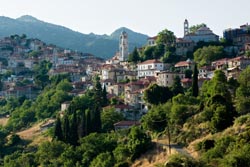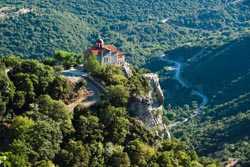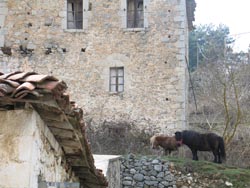You need to upgrade your Flash Player
Please visit Adobe's Flash Player site to upgrade the most recent version.
Thank you.
If you are having issues with installing Adobe Flash Player, please make sure that all "pop-up killer" applications are turned off and you reinstall
the Adobe player.
Arcadia
Information about Arcadia
Vacation and accommodation in Greece is a complete Travel Guide for Greece. In Vacation-Greece you will find information on Greek islands and a list of hotels and villas in Peloponnese, studios and apartments for all budgets. Find hotel offers in Peloponnese, see maps and photos of Peloponnese, book flights, ferry tickets, discover Peloponnese, book guided tours and make hotel reservations.

 A historical flashback
A historical flashback
The Arcadians are believed to be among the oldest inhabitants of the Peloponnese. Initially divided into tribes, they united alter the first millennium and founded great cities After their subjugation by the Romans (146 BC), the region fell into decline and political insignificance. In 1205 the Franks conquered Arcadia, founding baronies and erecting castles on the hilltops. In 1330 Andronikos Palaiologos won supremacy over the Franks. Arcadia was liberated in 1828.
A brief introduction
Arcadia is a closed land, all mountains and high peaks with large fir forests and lush vegetation. An unspoiled land, little known, full of surprises, truly bewitching. On the eastern coast it is washed by the gulf of Argos and the Mirtoo sea. Here and there the sea has carved fantastic bays and peninsula out of the land.
In fact, whoever roams through Arcadia today will get to know a part of the country that has remained virtually unchanged since antiquity. Arcadia is a natural wonderland whose mountain dwellers have preserved it intact up to today.
 The land of Arcadia
The land of Arcadia
Leonidion, sea and lush plain. Old mansions with courtyards and high walled gardens. Houses with symmetrical windows and skylights. Artfully designed chimneys. Painted shutters. Decorated doorways. Stately houses with wood-panelled floors and moulded ceilings As you stroll around you feel tradition coming alive with your every step in this lovely town.
Holy Saturday in Leonidion The bells toll in a festive way. Firecrackers hiss and bang in the streets non-stop. "Judas" figures burn outside the churches. Noise, commotion. Lights are carried from one neighbourhood to another The skies aglow with the beams of countless lanterns. Oh Easter Sunday the festivities reach their peak. Roast meat, wine, sweets, fritters, offered free to all comers. Locals and strangers. A gesture of traditional gentility.
Further on there's Plaka; a charming little port with a pebbly beach. Shining next to the sea. To the south, Poulithra, with its old stone houses and marvellous beaches.
To the north, little bays Sabatiki, Livadi quaint unforgettable fishing hamlets. Tiros beach. An enormous expanse of sand and gleaming pebbles. Relaxation and warmlh. Just above it the beach of Agios Andreas. Dazzing azure seas. Fishing caiques and tavernas. Sky, sea and land in endless serenity. Paralia Astros. White on a green and blue background. A verse from a poem. Blue and the slap of oars on the water. Shady trees and "tavernoules". The sweet smell of grilling octopus. A fisherman is untangling his net on the wharf. From here the Toad branches off to the mountains, Mt Parnon. The drive is exciting, the countryside wild am unspoilt. Tiny villages, farmhouses. Plalanos, Prastos Agios Petros.
 Cottages, manor houses towers and monasteries. The monasteries of Loukou, Elonas, Palaiopanagia Eortakousti, Karia, John the Forerunner. Awesome silent and strangely comforting. Lighted candles an faint frescoes.
Cottages, manor houses towers and monasteries. The monasteries of Loukou, Elonas, Palaiopanagia Eortakousti, Karia, John the Forerunner. Awesome silent and strangely comforting. Lighted candles an faint frescoes.
The mountains of Arcadia
Towering peaks, precipices and deep gorges. Rivers an running brooks. Thick vegetation. Ancient cities, Byzantine churches. Frankish fort. Towns, villages, traditional settlements.
Woodcutters, shepherds, carpenters, craftsmen and masons. Mountain people, free and indomitable. Tripolis is the capital of the prefecture. Built in the centre of wooded plateau, it is one of the most important agricultural, commercial and transportation hubs in the Peloponnese. The city is embellished by the Byzantine church of Agios Vassilis and some neoclassical houses, one of which houses the archaeological museum. To the north is Levidi, a pretty village (alt 800 m.), the landscape round about is astonishing, a sea of green spruce and fir as far as the eye can see. The glory of antiquity and Byzantium. The monastery of Epano Hrepas with frescoes of the Cretan School. Mantinia, Tegea, Pallation, Assea, Orhomenos, ancient Arcadian cities. Ruined walls, theatres, public buildings. The temple of Athena Alea (370 BC). The monastery of the Virgin Gorgoepikoos (10th c with 16th c. Frescoes).
Megalopolis, the original Great City. The agora, sanctuary of Zeus, theatre (and a small museum in town). Leondari, Byzantine churches and a ruined Frankish castle. Likossoura, the sanctuary of the great goddess Despina and Demeter. (The local museum has copies of the cult statues from the temple on exhibit in the National Archaeological Museum in Athens). On our way, we find the picturesque village Likeo, and a little further, Ano Karies, with plenty of walnut trees. From this place, it is worth the pain to climb at the top the Mountain Likeo.
At an altitude of 1.200m, there is a small plateau, plenty of ruins of the sanctuary of Pan, of the Hippodrome a Stadium. This is wheve "Likea" games of children and Men were taking place in honour of Zeus.
A little higher there was a big altar, where sacrifcies were offered to Zeus. At a steep slope, we see the villa Isari. At the foot of the village, there is the small vaulted church of Ag. Theodora, with freskoes of 11th century at the roof of which 17 huge trees have sprouted.
Karitena, the "Toledo of Greece". Stone houses, narrow lanes, Byzantine churches, a Frankish castle.
Nearby Ancient Gortina and the river Loussios. The river takes its name from the Greek word "louzo" = to wash or bathe, because Zeus as a child was said to have bathed in its waters. A walk along its banks is to experience a new definition of beauty. A delightful corner of Arcadia. Next door is the monastery of the Prodromos with frescoes from the 14th and 15th century. And down a ravine the monastery of the Philosophos with more Byzantine wall paintings. And the later monastery of Aimialon wedged into a mountainside with 17th century frescoes.
Stemnitsa (alt.1.100 m) Old stone houses, Byzantine churches, little cafes and tavernas, a lovely folk museum, the scenery greener than green. Dimitsana (alt. 1000 m.), cobbled lanes, wooden balconies, tiled roofs. A respect for local architectural tradition, an impressive library and folk art museum. Churches and gunpowder mills.
Loutra Iraias, forests of pine and fir. Hot springs. Ruins of ancient Heraia on the hillside.
 Vitina (alt. 1060 m.). More fir trees and fresh air. A wonderful climate. Beautiful countryside and running brooks. A park for walks. Traditional cooking. Here everyone seems to be occupied in woodcarving. There are carved objects in original shapes and styles in the shop windows, ad every church has its own magnificently worked icon screen.
Vitina (alt. 1060 m.). More fir trees and fresh air. A wonderful climate. Beautiful countryside and running brooks. A park for walks. Traditional cooking. Here everyone seems to be occupied in woodcarving. There are carved objects in original shapes and styles in the shop windows, ad every church has its own magnificently worked icon screen.
Alonistena (alt. 1250 m). The village is located at approximately 9km south-west of Vytina. The way to Alonistena passes by a rich evergreen forest visitors must see. Access to the village can alsobe made via Tripoli.
Magouliana (alt. 1.360 m.). Its old stone houses with red tiled roofs dusted with frost on a winter afternoon. A landscape that legends are made of. A Byzantine castle overlooks the village. To your left Lagadia with its impressive old mansions and venerable churches.
To your right Valtesiniko (alt. 1.150 m.) clinging to the mountainside. The joy of all this green. Apple trees, walnut trees, poplars and firs. A cup of coffee in the village cafe with the locals is a real pleasure. The people of Valtesiniko are warm hospitable and simple folk. There is a woodcarvers' school in the village, and many of the residents take up the craft. On a slope overlooking the whole village stands the church of St. George (1830) with an octagonal dome. One's eye is caught by the scenes carved into the icon screen and other church furniture.
About a kilometre away is the church of the Dormition of the Virgin - an old monastery church founded in 1625 with partially destroyed frescoes. From here you can see the rocks of Agionikola. A stairway with 100 steps takes you up to the cave which conceals two churches, Agionikola and Analipsis. These churches with frescoes from 1570, embrasures hollowed out of the walls and crypts hide the secrets of another era.
This is Arcadia: Plenty of mountains, vegetation, rumors and history.

 A historical flashback
A historical flashbackThe Arcadians are believed to be among the oldest inhabitants of the Peloponnese. Initially divided into tribes, they united alter the first millennium and founded great cities After their subjugation by the Romans (146 BC), the region fell into decline and political insignificance. In 1205 the Franks conquered Arcadia, founding baronies and erecting castles on the hilltops. In 1330 Andronikos Palaiologos won supremacy over the Franks. Arcadia was liberated in 1828.
A brief introduction
Arcadia is a closed land, all mountains and high peaks with large fir forests and lush vegetation. An unspoiled land, little known, full of surprises, truly bewitching. On the eastern coast it is washed by the gulf of Argos and the Mirtoo sea. Here and there the sea has carved fantastic bays and peninsula out of the land.
In fact, whoever roams through Arcadia today will get to know a part of the country that has remained virtually unchanged since antiquity. Arcadia is a natural wonderland whose mountain dwellers have preserved it intact up to today.
 The land of Arcadia
The land of ArcadiaLeonidion, sea and lush plain. Old mansions with courtyards and high walled gardens. Houses with symmetrical windows and skylights. Artfully designed chimneys. Painted shutters. Decorated doorways. Stately houses with wood-panelled floors and moulded ceilings As you stroll around you feel tradition coming alive with your every step in this lovely town.
Holy Saturday in Leonidion The bells toll in a festive way. Firecrackers hiss and bang in the streets non-stop. "Judas" figures burn outside the churches. Noise, commotion. Lights are carried from one neighbourhood to another The skies aglow with the beams of countless lanterns. Oh Easter Sunday the festivities reach their peak. Roast meat, wine, sweets, fritters, offered free to all comers. Locals and strangers. A gesture of traditional gentility.
Further on there's Plaka; a charming little port with a pebbly beach. Shining next to the sea. To the south, Poulithra, with its old stone houses and marvellous beaches.
To the north, little bays Sabatiki, Livadi quaint unforgettable fishing hamlets. Tiros beach. An enormous expanse of sand and gleaming pebbles. Relaxation and warmlh. Just above it the beach of Agios Andreas. Dazzing azure seas. Fishing caiques and tavernas. Sky, sea and land in endless serenity. Paralia Astros. White on a green and blue background. A verse from a poem. Blue and the slap of oars on the water. Shady trees and "tavernoules". The sweet smell of grilling octopus. A fisherman is untangling his net on the wharf. From here the Toad branches off to the mountains, Mt Parnon. The drive is exciting, the countryside wild am unspoilt. Tiny villages, farmhouses. Plalanos, Prastos Agios Petros.
 Cottages, manor houses towers and monasteries. The monasteries of Loukou, Elonas, Palaiopanagia Eortakousti, Karia, John the Forerunner. Awesome silent and strangely comforting. Lighted candles an faint frescoes.
Cottages, manor houses towers and monasteries. The monasteries of Loukou, Elonas, Palaiopanagia Eortakousti, Karia, John the Forerunner. Awesome silent and strangely comforting. Lighted candles an faint frescoes.
The mountains of Arcadia
Towering peaks, precipices and deep gorges. Rivers an running brooks. Thick vegetation. Ancient cities, Byzantine churches. Frankish fort. Towns, villages, traditional settlements.
Woodcutters, shepherds, carpenters, craftsmen and masons. Mountain people, free and indomitable. Tripolis is the capital of the prefecture. Built in the centre of wooded plateau, it is one of the most important agricultural, commercial and transportation hubs in the Peloponnese. The city is embellished by the Byzantine church of Agios Vassilis and some neoclassical houses, one of which houses the archaeological museum. To the north is Levidi, a pretty village (alt 800 m.), the landscape round about is astonishing, a sea of green spruce and fir as far as the eye can see. The glory of antiquity and Byzantium. The monastery of Epano Hrepas with frescoes of the Cretan School. Mantinia, Tegea, Pallation, Assea, Orhomenos, ancient Arcadian cities. Ruined walls, theatres, public buildings. The temple of Athena Alea (370 BC). The monastery of the Virgin Gorgoepikoos (10th c with 16th c. Frescoes).
Megalopolis, the original Great City. The agora, sanctuary of Zeus, theatre (and a small museum in town). Leondari, Byzantine churches and a ruined Frankish castle. Likossoura, the sanctuary of the great goddess Despina and Demeter. (The local museum has copies of the cult statues from the temple on exhibit in the National Archaeological Museum in Athens). On our way, we find the picturesque village Likeo, and a little further, Ano Karies, with plenty of walnut trees. From this place, it is worth the pain to climb at the top the Mountain Likeo.
At an altitude of 1.200m, there is a small plateau, plenty of ruins of the sanctuary of Pan, of the Hippodrome a Stadium. This is wheve "Likea" games of children and Men were taking place in honour of Zeus.
A little higher there was a big altar, where sacrifcies were offered to Zeus. At a steep slope, we see the villa Isari. At the foot of the village, there is the small vaulted church of Ag. Theodora, with freskoes of 11th century at the roof of which 17 huge trees have sprouted.
Karitena, the "Toledo of Greece". Stone houses, narrow lanes, Byzantine churches, a Frankish castle.
Nearby Ancient Gortina and the river Loussios. The river takes its name from the Greek word "louzo" = to wash or bathe, because Zeus as a child was said to have bathed in its waters. A walk along its banks is to experience a new definition of beauty. A delightful corner of Arcadia. Next door is the monastery of the Prodromos with frescoes from the 14th and 15th century. And down a ravine the monastery of the Philosophos with more Byzantine wall paintings. And the later monastery of Aimialon wedged into a mountainside with 17th century frescoes.
Stemnitsa (alt.1.100 m) Old stone houses, Byzantine churches, little cafes and tavernas, a lovely folk museum, the scenery greener than green. Dimitsana (alt. 1000 m.), cobbled lanes, wooden balconies, tiled roofs. A respect for local architectural tradition, an impressive library and folk art museum. Churches and gunpowder mills.
Loutra Iraias, forests of pine and fir. Hot springs. Ruins of ancient Heraia on the hillside.
 Vitina (alt. 1060 m.). More fir trees and fresh air. A wonderful climate. Beautiful countryside and running brooks. A park for walks. Traditional cooking. Here everyone seems to be occupied in woodcarving. There are carved objects in original shapes and styles in the shop windows, ad every church has its own magnificently worked icon screen.
Vitina (alt. 1060 m.). More fir trees and fresh air. A wonderful climate. Beautiful countryside and running brooks. A park for walks. Traditional cooking. Here everyone seems to be occupied in woodcarving. There are carved objects in original shapes and styles in the shop windows, ad every church has its own magnificently worked icon screen.
Alonistena (alt. 1250 m). The village is located at approximately 9km south-west of Vytina. The way to Alonistena passes by a rich evergreen forest visitors must see. Access to the village can alsobe made via Tripoli.
Magouliana (alt. 1.360 m.). Its old stone houses with red tiled roofs dusted with frost on a winter afternoon. A landscape that legends are made of. A Byzantine castle overlooks the village. To your left Lagadia with its impressive old mansions and venerable churches.
To your right Valtesiniko (alt. 1.150 m.) clinging to the mountainside. The joy of all this green. Apple trees, walnut trees, poplars and firs. A cup of coffee in the village cafe with the locals is a real pleasure. The people of Valtesiniko are warm hospitable and simple folk. There is a woodcarvers' school in the village, and many of the residents take up the craft. On a slope overlooking the whole village stands the church of St. George (1830) with an octagonal dome. One's eye is caught by the scenes carved into the icon screen and other church furniture.
About a kilometre away is the church of the Dormition of the Virgin - an old monastery church founded in 1625 with partially destroyed frescoes. From here you can see the rocks of Agionikola. A stairway with 100 steps takes you up to the cave which conceals two churches, Agionikola and Analipsis. These churches with frescoes from 1570, embrasures hollowed out of the walls and crypts hide the secrets of another era.
This is Arcadia: Plenty of mountains, vegetation, rumors and history.

